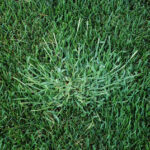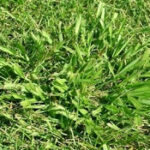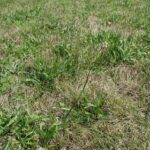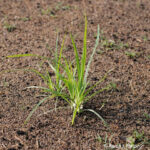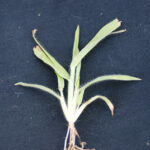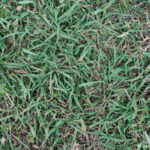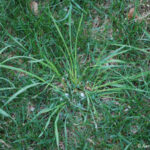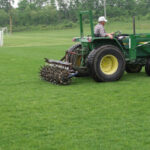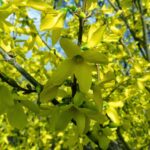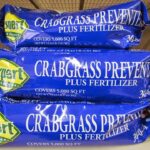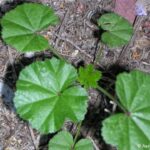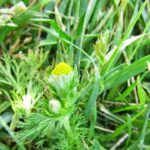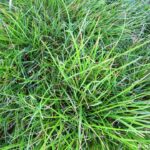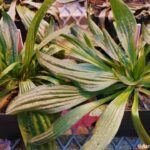Category: Weed Control
2017 Turf Weed Control for Professionals, Now Available
Now available, the revised edition of Turfgrass Weed Control for Professionals. This sixth edition, released in February 2017, includes major modifications including: Eleven states (IA, IL, KS, KY, MI, MN, MO, NE, NY, OH, WI) were added as well as their experts as collaborators to transform this to a multi-state publication. The identification of 105 weeds […]
Crabgrass is out in full force in 2016!
Why is crabgrass so bad this year? Several factors contribute to a bad year for crabgrass. Crabgrass is a warm-season grass meaning that it thrives in hot conditions with optimum growth in temperatures ranging from 88 to 95 °F. However, our primary lawn species in Indiana are cool-season grasses and they prefer cooler conditions and […]
Field Paspalum
Field Paspalum Biology: Field paspalum (Paspalum laeve Michx.) is a warm-season perennial weed with short rhizomes similar to dallisgrass (Paspalum dilatatum Poir.). Much of the below Weed of the Month entry comes from research conducted in Indiana on how to control Field Paspalum. That research was published in 2012. Reicher, Z.J., A.J. Patton, and […]
Common Purslane
Purslane Biology: Common purslane (Portulaca oleracea L.) is a summer annual broadleaf weed (Fig. 1) that is commonly found in low maintenance turf swards (Fig. 2), turf seeded in summer (Fig. 3), next to sidewalks and driveways, and in mulched beds and gardens (Fig. 4). Purslane is a succulent plant with a prostrate growth habit, […]
Look Out for Herbicide Resistant Weeds in Turf
Herbicide resistance can be defined as the acquired ability of a weed population to survive an herbicide application that previously was known to control the population. The number of herbicide resistant weeds has been rapidly increasing in agriculture in recent years. Currently, 459 unique cases of herbicide resistant weeds exist globally, with 246 species (143 […]
Wet Weather Makes a Great Environment for Yellow Nutsedge
Yellow nutsedge is a troublesome, difficult-to-control turf weed. Information on its identification is available in a recent weed of the month blog posting. Wet, summertime conditions like we are now having favor its growth and development. Understanding this plant’s biology will help in determining the best control methods. Two Purdue publications are also available to […]
Postemergence Crabgrass Control
As crabgrass grows larger and larger this spring into summer, you’ll need to know just how big it is before selecting the right product for postemergence control. Read my recent article to turf professionals at Turf Republic: Just How Big is Your Crabgrass? For homeowners, look for products that contain quinclorac such […]
Quackgrass
Quackgrass Biology: Quackgrass ( Elymus repens) is a cool-season perennial that vigorously spreads by rhizomes. It is a sod-forming grass that can crowd out desirable grasses and even other weeds. Quackgrass has been shown to be allelopathic, which means it releases chemicals that inhibit the growth of other plants. Large, nearly pure patches of […]
Orchardgrass
Biology: Orchardgrass (Dactylis glomerata), is a clump-forming, or bunch-type, cool-season grassy weed found throughout the Midwestern United States. It is typically used as a type of grazing or forage grass in pastures but it can be a weed in turf. It’s bunch-type growth pattern, light blue-greenish color, ability to tolerate partial shade, and rapid […]
Is it Safe to Aerify after Applying a Preemergence Herbicide?
It is not uncommon for me to receive questions regarding whether it is OK to aerify an area when you’ve already applied a preemergence herbicide to control crabgrass. Will aerifying break the herbicide barrier and reduce my crabgrass control? The answer to this and more can be found here in a recent post I wrote […]
Common Questions About Crabgrass Germination and Preemergence Herbicides Answered
This time of year many have questions about crabgrass germination and control. Below are several previous Purdue turf tips that answer the most commonly asked questions about crabgrass control. When will crabgrass germinate? When should I apply my preemergence herbicide (crabgrass preventer)? Which preemergence herbicide should I use? – Professionals How to Select a Crabgrass […]
How to Select a Crabgrass Preventer from the Store – Homeowners
Crabgrass is a summer annual weed that germinates in lawns each spring (click here for crabgrass identification information). Preemergence herbicides prevent emergence of crabgrass plants from the soil. These products must be applied prior to crabgrass germination which could occur as early as April 1 in southern Indiana and three or more weeks later in […]
Dandelion
Dandelion Biology: Dandelion (Taraxacum offinianale), is a broadleaf perennial weed that can be found in lawns, nursery crops, and landscapes throughout the United States. It has the ability to survive many different soil types, environmental conditions, and management practices; thus, it is a commonly found weed in lawns throughout the northern half of […]
2015 Turf Weed Control for Professionals, Now Available
The revised edition of Turfgrass Weed Control for Professionals is now available. The 96 page publication includes content on: Turfgrass Culture Weed Types Weed Life Cycles Developing a Weed Control Program Indicator Weeds Herbicide Information (use, nomenclature, classification, mode of action, movement, resistance, etc.) Control of Tough Weeds Frequently Asked Questions and Answers About […]
Common Mallow
Common Mallow Biology: Common mallow (Malva neglecta), also known as cheese mallow, cheese weed, and dwarf mallow, is a winter annual broadleaf weed, though it can also act as a biennial if environmental conditions that favor growth persist. It is generally found in low-maintenance turfgrass lawns, nursery crops, and landscapes. The ability of […]
Pineapple Weed
Pineapple Weed Biology: Pineapple weed (Matricaria matricariodies), behaves as either a summer or winter annual and it is commonly found throughout the United States. It is a weed of both high- and low-maintenance turfgrass lawns, landscapes, and nursery crops. Its ability to tolerate low mowing heights and highly compacted soils allow pineapple weed to […]
Roughstalk Bluegrass
Roughstalk Bluegrass Biology: Roughstalk bluegrass, primarily known by its scientific name (Poa trivialis), is a cool-season perennial grass that can be found throughout the Midwestern United States. Though roughstalk bluegrass can be found in landscapes, roadsides, meadows, and waste areas, it is primarily considered a turfgrass weed. It can successfully germinate in multiple environmental […]
Buckhorn Plantain
Buckhorn Plantain Biology: Buckhorn plantain (Plantago lanceolata) is a perennial broadleaf that can be found in sites that are typically dry and consist of neutral to basic soils. Like the closely-related broadleaf plantain (Plantago major), buckhorn plantain can often be found in compacted soils but does not tolerate injury from constant traffic stress. It […]
Weed Management Next to Sidewalks and Driveways
Weed management next to sidewalks is difficult for several reasons outlined below. These “hot spots” for weed invasion become quite evident during summer as weeds encroach and turf quality declines. The below section outlines some of the causes for hot spots and how to best manage weeds in these areas. Soils are shallow in these […]
Crabgrass Germination Coming Soon!
This time of year many have questions about crabgrass control. Below are several previous Purdue turf tips that answer the most commonly asked questions about crabgrass control. When will crabgrass germinate? When should I apply my preemergence herbicide (crabgrass preventer)? Which preemergence herbicide should I use? How do I control crabgrass in spring seeded turf? […]

